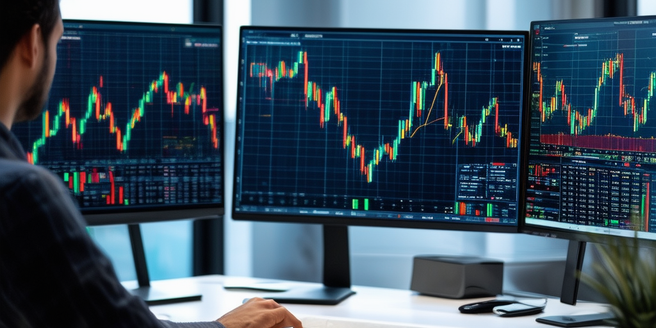Understanding the Basics of Forex Trading
Forex trading, or the foreign exchange market, is where currencies are traded. This market is a hub of international economic activity, providing a platform for businesses, investors, and governments to buy and sell currencies. Essentially, it serves as the backbone of purchasing and selling between different currencies. This form of trading is a key component of international finance, connecting markets from all over the globe. It’s the largest and most liquid market in the world, with over $5 trillion traded daily. Investors buy and sell currencies hoping to profit from fluctuations in their values. Exchanges can be as simple as buying one currency while simultaneously selling another – this is known as a currency pair. Most Forex trading revolves around the U.S. dollar, Euro, British pound, Japanese yen, and Swiss franc.
Techniques to Identify Profitable Trends
Trend trading, a prevalent investment strategy in Forex trading, involves determining an asset’s momentum and ‘taking a position’ in that direction, based on an asset’s market trend. In Forex trading, spotlighting trends is vital since an enduring uptrend or downtrend often indicates a spike in buyer or seller activity, and strong market sentiment. To identify these market trends, various technical analysis tools like moving averages, the relative strength index (RSI), and the moving average convergence divergence (MACD) are used. The influence of macroeconomic factors and global events on market trends also cannot be ignored, as these significantly impact large market participants’ actions and shifts in demand and supply. Consequently, traders, while using technical analysis to identify trends, need to also monitor the global economic landscape and major events for clues regarding potential trend formations and shifts.
Smart Risk Management in Forex Trading
Risk management is a fundamental component of successful Forex traders’ strategies, primarily aimed at limiting potential losses to safeguard trading capital. This crucial aspect of Forex trading often involves using stop-loss orders–a defensive mechanism that closes a trade if the market exchange rate moves unfavorably against a trader’s position. This technique provides a safety layer, ensuring financial losses don’t surpass a challenging-to-recover threshold and allowing traders to continue participating in the Forex market.
In trading, the potential for reward comes with accompanying risk. By carefully managing your risk-to-reward ratio–a measure of the financial risk you’re willing to undertake for potential profit–you can significantly extend your duration in the game. This ratio allows you to analyze and balance your risk exposure. A trade is considered worthwhile if the potential reward outweighs the estimated risk. Conversely, if the risk is too high relative to the reward, a seasoned trader may choose to skip the trade. Maintaining a favorable risk-to-reward ratio isn’t about winning every trade; it’s about being solvent and staying in the game longer. Ultimately, as a trader, your end goal is to ensure that your overall wins outweigh your losses.
Optimizing your Trading Strategy for Success
Developing a successful trading strategy requires a fusion of technical analysis, comprehensive market understanding, and disciplined execution. Called the study of market trends through historical price movements, technical analysis is combined with market understanding, which emphasizes global economic circumstances such as political climate, interest rates, and news events. Combining these two components with disciplined execution—making decisions logical, not emotional—can streamline your trading strategy. Continuous review and improvement are key as market conditions are dynamic and change over time; so, your strategy must adapt accordingly to shifts in the global and local markets. The use of backtesting—testing your strategy using historical data—can evaluate your strategy’s effectiveness, provide insights into how your strategy would’ve performed in the past, and reveal areas for improvement. Diversification in your strategy can lessen risks and augment returns by spreading investments across multiple financial assets. Continuous learning is also integral since the financial market is continuously changing, equipping oneself with new market trends, investment strategies, and financial regulations can help refine your strategy. In conclusion, creating a successful trading strategy is a continuous process involving technical analysis, understanding market trends, disciplined execution, constant evaluation and improvement, diversification, and continuous learning.
The Role of Psychology in Forex Trading
The role of psychology in Forex trading is vital as it intertwines with the financial and technical elements of the trade. Emotional factors like fear, greed, excitement, overconfidence can influence your trading decisions and cloud judgement, leading to irrational behavior. Overcoming these requires a lot of discipline, patience, and a relentless focus on long-term goals.
Both novice and affluent traders should cultivate a balanced mindset, not swaying from highs and lows, as it promotes consistency, a crucial characteristic of successful trading. Also, they should meticulously follow a solid trading plan that provides structure and guidelines and acts as a beacon during tumultuous market situations. Adherence to this plan can help manage the psychological aspects of Forex trading and maintain confidence during downturns. Following the plan irrespective of setbacks or success provides a stable foundation for a trading journey. In conclusion, psychology, discipline, and planning are the pillars that shape a successful Forex trader’s journey.


